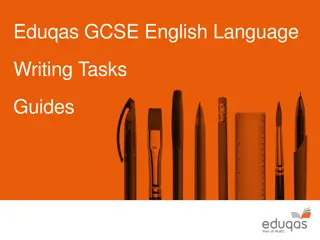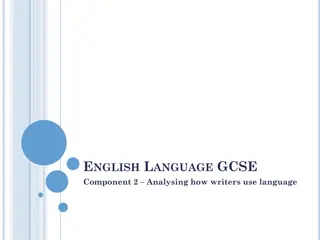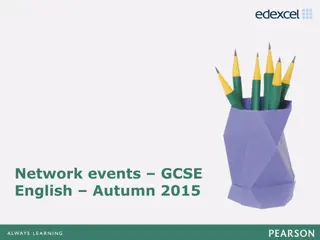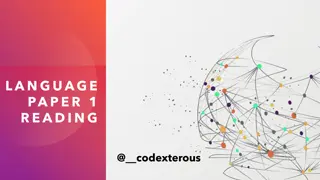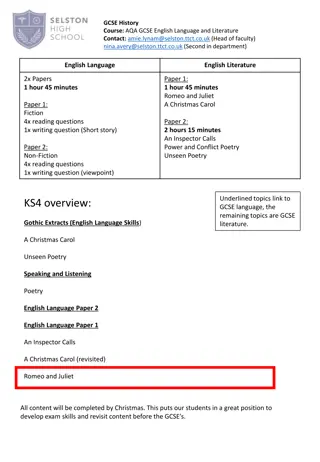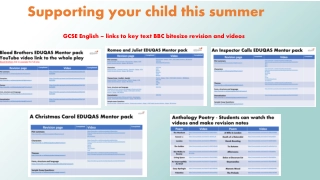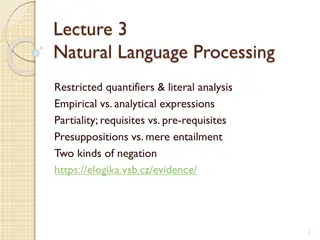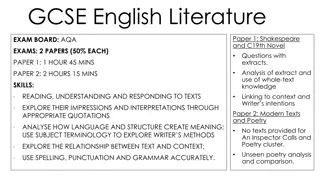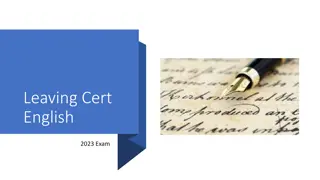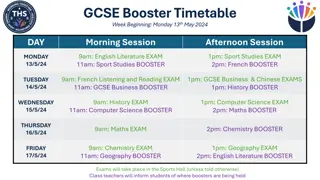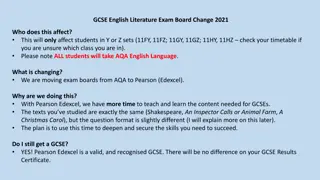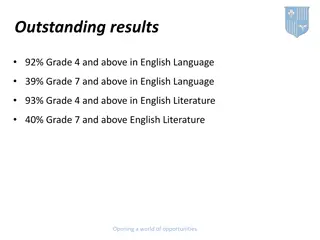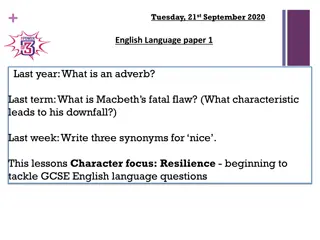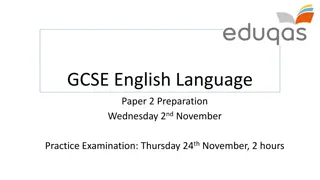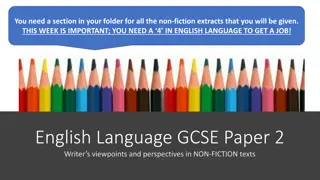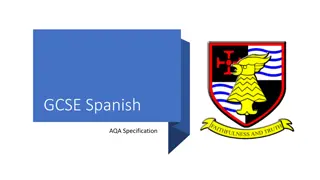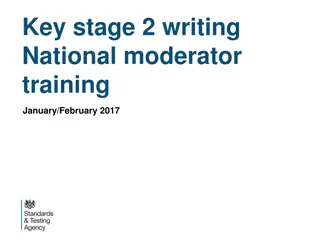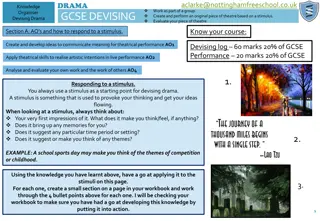Mastering GCSE Analytical Writing and Language Techniques
Enhance your GCSE analytical writing skills with tips on PEEE structure, language features, and structure mnemonic like NESTS for narrative voice. Dive into paragraphs, sentence structures, and descriptive/figurative language techniques. Explore the persuasive and rhetorical language elements like AFOREST, SPAMROD, and newspaper article form. Elevate your writing proficiency with detailed guidance and examples.
Uploaded on Sep 23, 2024 | 0 Views
Download Presentation

Please find below an Image/Link to download the presentation.
The content on the website is provided AS IS for your information and personal use only. It may not be sold, licensed, or shared on other websites without obtaining consent from the author. Download presentation by click this link. If you encounter any issues during the download, it is possible that the publisher has removed the file from their server.
E N D
Presentation Transcript
GCSE Analytical writing PEEE(L): Point your answer to the question; Evidence a quotation from the text; Explain what the quote means/effect on the reader; Explore analysis of language, features, structure, device, context, perspective Link link back to the question
GCSE Analytical writing Language and structure: what to look for Words types of words e.g. verbs, adjectives etc.; Phrases groups of words/short sentences; Language features SPAMROD/AFOREST; Language techniques tense, tone, direct address, pathetic fallacy, semantic fields etc.; Sentence forms SCS1.
GCSE Structure NESTS: Narrative voice End Start/beginning SUPPORT: Use this mnemonic as a guide to help you think about structure. Tense/turning point Sentences and paragraphs
GCSE Paragraphs Paragraphs: Time Place Topic Person
GCSE Monday, 23 September 2024 Sentences Sentence Structures: Simple Compound Subordinate 1word
GCSE Descriptive/Figurative Language (P1 Q5) SPAMROD: Simile Personification Alliteration Metaphor Repetition Onomatopoeia Description based on the 5 senses
GCSE Persuasive/Rhetorical Language (P2 Q5) AFOREST: EXTENSION FEATURES: Hyperbole exaggeration for effect or emphasis Litotes understatement for effect Irony expressing meaning by using language that suggests the opposite (last thing you would expect) Alliteration Fact Opinion Rhetorical question Emotive language Statistic Triples
GCSE Form (P2 Q5) Newspaper Article: TERROR ON THE STREETS! Body text uses features of SCS1, SPAMROD and AFOREST as newspapers often give opinion. Broadsheets tend to use more polysyllabic vocabulary. Headline known as a banner. In tabloids, often uses a pun There was panic in the streets of Portsmouth yesterday after a prolonged conflict between two rival gangs. A long running disputer for the past three years. Viciousassault A witness, Mrs Biddy, saw the fight from her living room. It was awful, she moaned. They were each other silly. Sub-heading used to separate the article into sections. Turf war The two groups, calling themselves Muppets the Losers have been involved in Why do we not use columns in an exam? the and slapping What would help create sub- heading in an exam?
GCSE Form (P2 Q5) Letter: Addresses 123 Fake Street Faketown Fakeshire FAKE 123 Yours top right Theirs to the left Date Mr Person 123 Person Street Persontown Personshire PERS 0N We DON T include these in an exam. Why? Monday 12th January 2015 Dear Mr. Person, Sign off. If you know the person use Yours sincerely, if you don t Yours faithfully Salutation: Blah blah blah . Yours sincerely, Dear Sir/Madam, or the name of the person you are writing to Body text in paragraphs using SCS1 and AFOREST C. O. M. Plainer
GCSE Form (P2 Q5) Blog: Body text you are giving an opinion use AFOREST to get your points across GIVING IS GREAT! We all like to receive. That s a fact. Christmas, birthdays, just to be nice. Giving makes us feel good. But there s more to it altruism is important, looking after each other is vital, sharing is the key. Headline When did you last give to charity? Get on with it fit it in! Too often we wait until it s a big event something like Children in Need or Armistice Day, then we open our creaking wallets and push a few coins towards a good cause to make us feel better. Is this enough? No? Sub-heading can use a more informal tone Always write in paragraphs using TiPToP Giving and charity needs to be central to everything we do
GCSE Form (P2 Q5) Transcript/Interview: Names: INTERVIEWER: Here s where I would write my question. So, does this make sense? The first speaker and the second. Make sure you end the name with a colon : PERSON: Well, yes. Here s where I write my answer. I would go into detail using a range of sentences from SCS1 as well as suitable features SPAMROD to describe and AFOREST to persuade. Write them in CAPITALS. Even though this is an interview, if I change topic, time, person or place I would still change paragraph. INTERVIEWER: And when I interrupt to ask a question you set the page out like this. Text of the conversation. Use SCS1 and features. Always write in paragraphs using TiPToP PERSON: Yes. Your questions come from the sub-headings in the main exam question.


